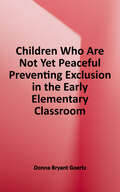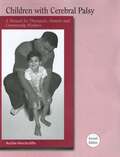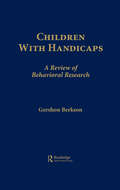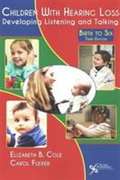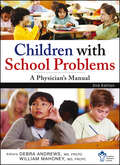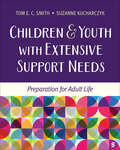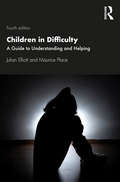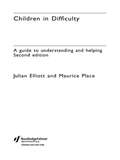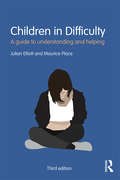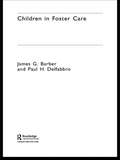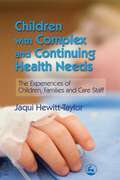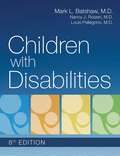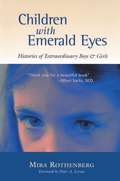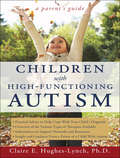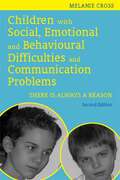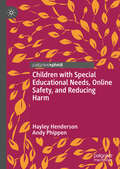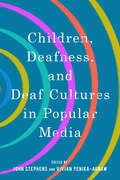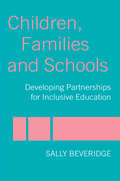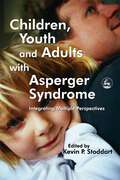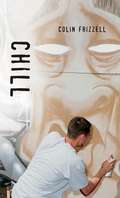- Table View
- List View
Children Who Are Not Yet Peaceful: Preventing Exclusion in the Early Elementary Classroom
by Donna Bryant GoertzCharting the progress of twelve children in a real Texas classroom, educator Donna Goertz shows how positive change can occur given the proper environment. In each case she describes a child's transformation from destructive troublemaker to responsible citizen of the classroom community. Readers will learn how to apply Montessori methods to virtually any early elementary environment.
Children With Autism: A Developmental Perspective (The Developing Child Ser.)
by Lisa Capps Marian SigmanChildren with Autism is unique in that it views autism through the lens of developmental psychopathology, a discipline grounded in the belief that studies of normal and abnormal development can inform and enhance one another. <P><P>Sigman and Capps conduct readers through the course of development from infancy to adulthood, outlining the differences between normal and autistic individuals at each stage and highlighting the links between growth in cognitive, social, and emotional domains. <P><P>In particular, Sigman and Capps suggest that deficits in social understanding emerge in the early infancy of autistic children, and they explore how these deficits organize the development of autistic individuals through the course of their lives. They also examine the effects certain characteristics can have on an autistic person's adjustment over time. Their book concludes with an overview of existing interventions and promising avenues for further research.
Children With Cerebral Palsy: A Manual for Therapists, Parents and Community Workers
by Archie HinchcliffeA large number of children in developing countries are born with or develop cerebral palsy. The problem is made worse by inadequate knowledge and treatment facilities. As a result, thousands of children with cerebral palsy live in burdensome dependence upon their families. This tragic situation can be avoided to a great extent by giving treatment early in the child′s life and also by guiding families on how to manage the children in ways that help them become independent. This book is a practical guide designed to help therapists and community workers understand and effectively treat children with cerebral palsy. It focuses on: - adequately assessing children with cerebral palsy - designing treatment programmes that can be carried out in partnership with parents and community workers - assessing and managing eating and drinking difficulties - making simple and cost-effective equipment - designing appropriate play activities during therapy - evaluating and dealing with sensory integration problems in children with cerebral palsy - closer integration of theory and practical skills.
Children With Handicaps: A Review of Behavioral Research
by Gershon BerksonPsychological research on children with mental and physical handicaps began two hundred years ago. Its major development awaited the maturation of psychology as an empirical science and of social movements for child welfare and education. This book is a record of the research accomplished in the 1980s. While at the end of the 19th century, behavioral research on handicapped children could at best be characterized as pioneering; by the beginning of the 1990s, it had become a vigorous activity with scientists producing hundreds of articles a year. The result has been a level of detail in theory and factual support that was not previously available. This volume is written for those who know something about psychology and education, but who are unfamiliar with research on children with handicaps. This might include parents of children with handicaps, upper-level undergraduate and graduate students looking for research topics, and professionals in developmental psychology and the education of normal children who wish to familiarize themselves with the recent developments in the study of deviations in behavioral development.
Children With Hearing Loss: Developing Listening and Talking, Birth to Six (3rd Edition)
by Carol Flexer Elizabeth B. ColeThe third edition of Children With Hearing Loss: Developing Listening and Talking, Birth to Six provides updated information from the previous two editions for both professionals and parents facilitating spoken language through listening (auditory brain access, stimulation, and development) in infants and young children with hearing loss. Also addressed is auditory brain development, audiologic technologies, auditory skill development, spoken language development, as well as family-focused intervention for young children with hearing loss whose parents have chosen to have them learn to listen and talk.
Children With High-Functioning Autism: A Parent's Guide
by Claire E. Hughes-LynchChildren With High-Functioning Autism: A Parent's Guide offers parents the information needed to help them cope with their child's autism and to navigate the path as they first perceive differences, seek assistance and treatment, and help their child develop into his or her full potential.Including examples of the author's own experiences with her child with autism, this book helps families realize that there are others on similar paths—and that help is available. With topics ranging from understanding the first signs of autism and the diagnosis, finding a support network, and filling out necessary paperwork, to determining the various types of therapies available and planning for adulthood, this book provides parents with valuable insight into this new world.With an emphasis on high-functioning autism, Pervasive Developmental Disorder-Not Otherwise Specified, and Asperger's syndrome, Children With High-Functioning Autism: A Parent's Guide helps parents learn to celebrate small areas of growth and keep the focus on the child.
Children With School Problems: A Physician's Manual
by The Canadian Paediatric Society William J. Mahoney Debra AndrewsThe physician's guide to diagnosing and treating learning disabilities in children1 in 10 Canadians have a learning disability, and doctors must be able to identify, diagnose, treat, and manage children who are struggling in school. The first book specifically tailored for the needs of physicians working with kids with learning disabilities, Children With School Problems: A Physician's Manual covers such important areas as child development, diagnosing learning disabilities (including data gathering, screening and assessment, and physical examinations), management (medication, behavioral management, and educational interventions), and prevention (including literacy promotion).Written by trusted experts from the Canadian Paediatric Society, Children With School Problems is filled with practical tools and resources that physicians--including paediatricians, family physicians, and paediatric learners--can use to diagnose and treat children with learning disabilities.The only book on learning disabilities in children specifically designed for physiciansWritten by trusted experts from the Canadian Paediatric SocietyCovers important issues including literacy promotion, screening for disabilities, medication options, and much moreGives physicians the tools they need to help children with learning disabilitiesPhysicians want to know more about learning disabilities, and parents want their pediatricians and family physicians to provide more help when their kids struggle in school. Children with School Problems provides that information, making it an invaluable resource for any doctor working with kids.
Children and Youth With Asperger Syndrome: Strategies for Success in Inclusive Settings
by Brenda Smith MylesHow can you make the school year successful for your students with Asperger Syndrome? Asperger syndrome (AS) is a disorder in the autism spectrum, and students with AS suffer from similar, though milder, symptoms as students with autism. Classroom teachers who are responsible for planning for and teaching students with AS generally have not been provided the skills and knowledge to do so. Children and Youth With Asperger Syndrome provides important strategies in teaching children and youth diagnosed with AS. This essential resource for teachers and other educators presents research-based, instructional, behavioral, and environmental strategies for teachers, including: Environmental modifications, including visual supports and organizational strategies Technology accommodations Transition planning Emotional, behavioral, and social supports
Children and Youth with Extensive Support Needs: Preparation for Adult Life
by Tom Smith Suzanne KucharczykChildren and Youth with Extensive Support Needs: Preparation for Adult Life, by Tom E. C. Smith and Suzanne Kucharczyk, takes a practical approach to prepare educators who will work with students with low incidence or complex disabilities. This text uniquely addresses the importance of preparing youth with significant support needs, starting earlier in their school years, for a high quality of life as adults. Smith and Kucharczyk stress the role of special education teachers in leading collaborative, interdisciplinary decision-making teams—including paraprofessionals, general educators, and families—to achieve better outcomes for students previously labeled as having severe disabilities. Equipped with evidence-based practices, in-depth exploration of essential skills for student success, and strategies for programmatic, technological, and interpersonal support, this text enables educators to better serve students with complex needs.
Children and Youth with Extensive Support Needs: Preparation for Adult Life
by Tom Smith Suzanne KucharczykChildren and Youth with Extensive Support Needs: Preparation for Adult Life, by Tom E. C. Smith and Suzanne Kucharczyk, takes a practical approach to prepare educators who will work with students with low incidence or complex disabilities. This text uniquely addresses the importance of preparing youth with significant support needs, starting earlier in their school years, for a high quality of life as adults. Smith and Kucharczyk stress the role of special education teachers in leading collaborative, interdisciplinary decision-making teams—including paraprofessionals, general educators, and families—to achieve better outcomes for students previously labeled as having severe disabilities. Equipped with evidence-based practices, in-depth exploration of essential skills for student success, and strategies for programmatic, technological, and interpersonal support, this text enables educators to better serve students with complex needs.
Children in Difficulty: A Guide to Understanding and Helping
by Julian Elliott Maurice PlaceThis fully updated fourth edition of Children in Difficulty explores some of the most common, yet incapacitating, difficulties often encountered by young children and adolescents. Drawing on the latest research and with case studies throughout, chapters cover topics such as challenging behaviour and school refusal, eating disorders, anxiety and depression, substance misuse, neurodevelopmental disorders, dyslexia and dyspraxia. The book provides a deeper understanding of each difficulty, considering the complexities of each problem at depth and analysing the best forms of intervention. It includes insights from the fields of genetics and neuroscience, and ensures that claims for the effectiveness of specific interventions are supported by rigorous scientific evidence. Features of this new edition include: Up-to-date insights from the fields of psychology, genetics and neuroscience Recognition of the increasing impact of social media and the internet on children and young people. Written by experts in the field, this book distils high level scientific and clinical knowledge in a way that is accessible to professionals from a range of child-care disciplines. It will be of significant value to those working in education, health or social care, and anyone who needs to be able to recognise and help children in difficulty.
Children in Difficulty: A guide to understanding and helping
by Julian Elliott Maurice PlaceWritten by two practising clinicians, this book is a guide for those who work with children. In clear, simple language it focuses upon some of the most common, yet often incapacitating, difficulties which are frequently encountered by young children and adolescents. After introducing and discussing different forms of therapy and treatment used in clinical work with children, the book focuses on a range of specific difficulties. Drawing upon recent research findings, and employing detailed case illustrations, it seeks to help the reader to understand the nature of each problem and offers a guide as to how the child in difficulty can best be helped. This new edition has been fully updated to include new material on conditions such as dyspraxia and ADHD. The authors also make full references to advances in the field of special education since the first edition was published, and provide a variety of sources for further reading and information. This practical book will be of particular value to those working in education, social work, health and child-care settings, and anyone else who needs to be able to recognise and help children in difficulty.
Children in Difficulty: A guide to understanding and helping
by Julian Elliott Maurice PlaceWritten by two leading experts in the field, this welcome third edition of Children in Difficulty: A guide to understanding and helping discusses some of the most common, yet incapacitating, difficulties that are frequently encountered by young children and adolescents. This includes such topics as: ADHD disruptiveness and challenging behaviour in schools and classrooms dyslexia and reading disability eating disorders oppositional defiance, conduct and attachment disorders childhood depression school refusal developmental coordination disorder (dyspraxia) less common mental health problems, such as bipolar disorder and obsessive compulsive disorder. traumatic and stressful situations drug and solvent abuse. The third edition of this book includes brand new insights from the fields of genetics and neuroscience and ensures claims for the effectiveness of specific interventions are supported by rigorous, scientific evidence. By drawing upon high level scientific and clinical knowledge and distilling it in a way that is accessible to professionals from a range of child care disciplines, this book will be of significant value to those working in education, health or social care, and anyone who needs to be able to recognise and help children in difficulty.
Children in Foster Care
by Paul Delfabbro James Barber Robyn GilbertsonResearchers, practitioners, journalists and politicians increasingly recognise that foster care throughout the world is in a state of crisis. There are more and more children needing care and, as residential alternatives dry up, more of these children are being assigned to foster families. This book reports the major findings of a two-year longitudinal study of 235 such children who entered the foster care system in Southern Australia between 1998 and 1999. As well as examining the changing policy context of children's services, the book documents the psychosocial outcomes for these children, their feedback on their experiences of care, and the views of their social workers and carers. In the process, the book examines some cherished beliefs about foster care policy and sheds new light on them.The research reveals that while most children do quite well in foster care up to the two-year point, there is a worrying amount of placement instability at a time when the concentration of emotionally troubled children in care is increasing throughout the western world. Although, surprisingly, placement instability does not appear to produce psychosocial impairment for a period of up to eight months in care, it has an extreme effect on children who are moved from placement to placement because no carer will tolerate their behaviour. These children are consigned to a life of distribution and emotional upheaval because of the lack of alternative forms of care. Another unexpected finding of the research is that increasing the rate of parental contact achieves little or nothing in relation to the likelihood of family reunification.As child welfare increasingly enters a world of research-based practice, Children in Foster Care provides some much needed hard evidence of how foster care policy and practice can be improved.
Children with Complex and Continuing Health Needs: The Experiences of Children, Families and Care Staff
by Jaqui Hewitt-Taylor'Aimed at students and practitioners involved in supporting such children, and designed to give them an insight into what it means to raise a child with such multiple needs.' - Current Awareness Service 'This book draws on the experiences of a number of families to provide a valuable and deeply moving insight into what it means to raise a child with complex needs. It highlights both the joys and the challenges that families face. In doing so it raises important issues about how services in the UK are currently responding to children with complex needs and their families as well as pervasive disablist attitudes within society. This book will provide students and practitioners from a range of disciplines with a valuable window into families' lives and challenge them to reflect on how they are supporting them.' - Sue Kirk, University of Manchester, UK. Focusing on the real life experiences of children and their families, this book provides valuable insight into living with complex and continuing health needs. The author highlights the importance of seeing each child as an individual, with the same rights and needs as any other person, rather than defining them by their health condition. The book includes case studies to illustrate the experiences of children, parents, siblings and extended families, as well as professionals in health and social care. These personal accounts discuss both the challenges and the rewards associated with looking after a child with complex needs. The author also provides an overview of the support which is available in healthcare and education systems and makes recommendations for the future. Anyone who is responsible for supporting children with complex and continuing health needs will benefit from reading this book.
Children with Disabilities
by Mark Batshaw Nancy Roizen Louis PellegrinoExplore what's new in the new edition! <P><P>Trusted for four decades by university faculty and relied on by thousands of professionals from diverse fields, Children with Disabilities is the gold-standard text on working effectively with children and families. Now this authoritative resource is in its eighth edition, enhanced with new chapters on critical topics, the latest evidence-based practices, updated instructor materials, and guidance on working with a wide range of professionals to address every aspect of child health and well-being. <P><P>Spearheaded by senior editor Mark Batshaw, M.D., Chief Academic Officer at Children's National Health System, this new edition is an unparalleled compendium of information about developmental, clinical, family, education, and intervention issues, from birth through adolescence. Every chapter has been meticulously peer-reviewed, and content has been updated throughout to reflect important new research and developments in diverse fields. Comprehensive coverage of contemporary issues makes this volume an indispensable reference for practicing professionals, and the student-friendly features and multimedia instructor materials make it the ultimate textbook for courses on disability. <P><P>A treasury of essential knowledge from a who's who of today's leading experts and innovators, Children with Disabilities is a cornerstone resource that professionals will use year after year to support their important work and ensure that every child and family thrives.
Children with Emerald Eyes: Histories of Extraordinary Boys & Girls
by Mira Rothenberg Peter A. LevineMira Rothenberg pioneered both the clinical distinction and treatment protocol for autistic and severely disturbed children as separate from those for the mentally retarded. Winner of a Woman of the Year award from the New York City Chamber of Commerce and the National Organization for Mentally Ill Children, she writes here eloquently of a lifetime of taking on seemingly hopeless cases and bringing these children, through painstaking therapy and love, back into the world. Children with Emerald Eyes includes case histories ranging from incarcerated teenagers to a profoundly autistic six-year-old, told with the same power and sympathy Rothenberg used in her practice.
Children with High Functioning Autism: A Parent's Guide
by Claire E. Hughes-Lynch"Children With High-Functioning Autism: A Parent's Guide" offers parents the information needed to help them cope with their child's autism and to navigate the path as they first perceive differences, seek assistance and treatment, and help their child develop into his or her full potential.
Children with Social, Emotional and Behavioural Difficulties and Communication Problems
by Melanie CrossChildren and young people with social, emotional and behavioural difficulties (SEBD) are far more likely to have communication problems than their peers, yet these problems are under-recognised, under-researched, and most importantly, often unaddressed. Melanie Cross considers the reasons why behavioural and communication difficulties so often occur together, and examines the social, educational and mental health implications of this. She shows that improving the communication skills of children and young people with SEBD can contribute to better outcomes, and that speech and language therapy is an important, yet often absent, service for this group. She provides practical guidelines for assessing communication, as well as useful strategies to help children and young people with SEBD to develop their communication skills. This second edition also contains information on unidentified and unmet communication needs in vulnerable young people, including young offenders and those at risk of social exclusion. This book will be an invaluable resource for speech and language therapists, social workers, teachers and other professionals working with children with emotional, behavioural and communication difficulties.
Children with Special Educational Needs, Online Safety, and Reducing Harm
by Andy Phippen Hayley HendersonThis book explores the online behavior and safeguarding of children with special education needs (SEN) in the digital world. Founded in research which evidences key stakeholder perspectives, this book informs and guides stakeholders towards sensibly balancing risk and opportunities online with an understanding that SEN children may face some unique challenges that can place them at greater risk. To develop a child-centered approach, the authors employ an ecosystems theory approach which considers child development as a system of interrelated relationships affected by multiple levels of surrounding environment, drawing upon Bronfenbrenner's seminal work and positioning the research within the field of education.
Children's Learning in Primary Schools: A guide for Teaching Assistants
by Mike CowdrayWhat does learning look like? What are different subjects really about? Why are transferable skills so important? How can we overcome the difficulties that children encounter in their learning? And what questions and prompts are likely to prove useful in helping children to get the most out of their lessons? The over-arching role of Teaching Assistants is to support teaching and learning in schools. To do this effectively, they need to understand the curriculum content of all the subjects in which they provide support and know what learning outcomes are sought. This accessible book provides an overview of the knowledge, skills, understanding and attitudes that children learn in each subject in their primary years. Written with the non-subject specialist in mind, and drawing on research and best practice in the classroom, this extremely practical book aims to provide the reader with the information they need to: deliver focused lessons to individual pupils, groups, or the whole class; concentrate on the most important elements when making classroom resources; make valuable assessments of the children’s learning, and keep useful records of their achievements, progress and difficulties; take a full part in discussions with colleagues – selecting objectives, devising interesting activities and delivering exciting lessons in each of the subjects. Including a wide range of examples and activities, this book will prove an invaluable companion for all students working on STLS and Foundation Degree courses, and Teaching Assistants currently working in primary schools.
Children, Deafness, and Deaf Cultures in Popular Media (Children's Literature Association Series)
by John Stephens and Vivian Yenika-AgbawContributions by Cynthia Neese Bailes, Nina Batt, Lijun Bi, Hélène Charderon, Stuart Ching, Helene Ehriander, Xiangshu Fang, Sara Kersten-Parish, Helen Kilpatrick, Jessica Kirkness, Sung-Ae Lee, Jann Pataray-Ching, Angela Schill, Josh Simpson, John Stephens, Corinne Walsh, Nerida Wayland, and Vivian Yenika-AgbawChildren, Deafness, and Deaf Cultures in Popular Media examines how creative works have depicted what it means to be a deaf or hard of hearing child in the modern world. In this collection of critical essays, scholars discuss works that cover wide-ranging subjects and themes: growing up deaf in a hearing world, stigmas associated with deafness, rival modes of communication, friendship and discrimination, intergenerational tensions between hearing and nonhearing family members, and the complications of establishing self-identity in increasingly complex societies. Contributors explore most of the major genres of children’s literature and film, including realistic fiction, particularly young adult novels, as well as works that make deft use of humor and parody. Further, scholars consider the expressive power of multimodal forms such as graphic novel and film to depict experience from the perspective of children. Representation of the point of view of child characters is central to this body of work and to the intersections of deafness with discourses of diversity and social justice. The child point of view supports a subtle advocacy of a wider understanding of the multiple ways of being D/deaf and the capacity of D/deaf children to give meaning to their unique experiences, especially as they find themselves moving between hearing and Deaf communities. These essays will alert scholars of children’s literature, as well as the reading public, to the many representations of deafness that, like deafness itself, pervade all cultures and are not limited to specific racial or sociocultural groups.
Children, Families and Schools: Developing Partnerships for Inclusive Education
by Sally BeveridgeEffective communication between the home and school is crucial for any child's education, but where special needs are concerned, creating good partnerships is essential. This book is concerned with home-school relations from an 'inclusive' perspective. Throughout, it highlights issues that are common across all children and families, those that reflect individual diversity and those that are of particular significance when children have special educational needs. Sally Beveridge provides debates on issues such as:* the conceptual and policy frameworks that form the background to this subject;* the fundamental nature of the learning environment that families represent for children;* the potential role of home-school relations in supporting the educational achievements of children from diverse backgrounds and with differing needs;* strategies for the development of positive communication with parents.This book offers a manageable overview of a complex topic, ensuring its appeal to students and practitioners alike.
Children, Youth and Adults with Asperger Syndrome: Integrating Multiple Perspectives
by Kevin StoddartThis book offers a comprehensive overview of clinical, research and personal perspectives on Asperger Syndrome, including contributions from parents and experts in the fields of psychology, social work, psychiatry, genetics, sexology and vocational counselling. It includes first-hand accounts from adults with AS, highlighting their difficulties in areas such as social competence and education. Specialist perspectives on AS, including sexuality and relationships, finding and keeping employment and anxiety and depression are sensitively addressed. The viewpoints of parents explore experiences of parenting AS individuals. These varied approaches to living with AS complement the emerging literature on theory, research and practice in this area. The broad scope of Children, Youth and Adults with Asperger Syndrome guarantees a wide readership among practitioners, students, parents, young people and adults with AS, educates service providers how to assist people with AS and suggests a model of interdisciplinary collaboration for administrators and funders.
Chill
by Colin FrizzellHow far will Chill and Sean go to expose a teacher's deception? (Orca Soundings)
